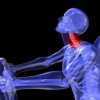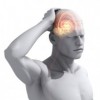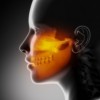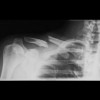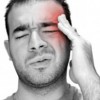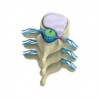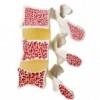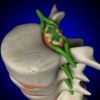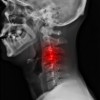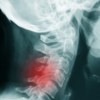Head & Neck
A Tension type Headache is the most common headache, accounts for 90% of all headaches and is responsible for over 50% of patient's that attend a GP with headache related pain. Tension type headache is the medical term used to describe those normal back ground headaches that we experience from day to day.
Symptoms include a tight band that feels like a constant dull ache, felt equally on both sides of the head. The dull ache normally starts at the base of the skull or in the forehead and then begins to gradually radiate round into the tight band. In a lot of cases discomfort, stiffness and muscles spasms are experienced in the neck and upper shoulders.
Whiplash occurs most commonly after a car accident but also can occur from falls that cause a jolt to the neck. Symptoms can be severe or very mild and onset can be immediate or can take anything from a few hours to a few days to completely materialize. Pain and stiffness are the most common symptoms. It will involve most of the neck and quite often creeps into the tops of the shoulders, into the upper back and down into the arms. Headaches and low back pain are common.
In some cases nausea, dizziness and blurred vision will happen immediately after the injury but will most likely only last for a short while. If you have been involved in a car accident or any trauma and suspect you may have whiplash then you must seek medical attention.
A Migraine is a recurrent severe and chronic type of neurological headache that affects more than 15% of the adult population in the UK and out of that it is 3 times more likely to affect women.
Symptoms include an intense severe throbbing and pulsating ache that develops around the forehead, eye socket and temple over one side of the face. A migraine builds up gradually and is precipitated by an aura in certain sufferers. Migraines commonly begin as a generalised headache over the temple or forehead, as the headache develops it tends to focus on one side of the face.
A cervicogenic headache is the medical term to describe head pain that is caused by an injury to the neck, shoulders or upper back. Any sustained spasm or strain to the neck muscles or sprain to the spinal joints in the neck can create a cervicogenic headache. The headache will feel like a general intense pounding ache around the prominent points of the temple, forehead or skull. The pain is constant and made worse by movements of the neck and shoulders or sitting in prolonged awkward postures. Neck stiffness will be prominent in most cases of cervicogenic headaches leading to a loss in neck mobility. This type of headache is very common in office workers and many find their headache develops over the course of the day being worse in the evening and easing with rest.
There are three main categories of TMJ (jaw) conditions. Myofascial pain (the most common), injury to the joint causing a dislocated jaw or locked jaw and conditions like rheumatoid arthritis and osteoarthritis. The most commonly related factor in jaw conditions is teeth clenching and grinding medically referred to as bruxism. Symptoms include a dull ache around the jaw which is often accompanied by a sharp pain on chewing movements. Ear pain and headaches are also common related symptoms.
Clavicle Fracture - Broken Collarbone
A clavicle fracture is the term for a break in the clavicle bone also known as the collarbone. It is one of the most common fractures in children and is responsible for up to 5 % of adult fractures. Clavicle fractures are normally the result from traumatic impact to the shoulder or traumatic falls.
Symptoms include a very intense immediate sharp pain around the fracture site along the top of the chest which often radiates up into the neck, down into the chest and into the arm of the affected side. The fracture is often accompanied by swelling and bruising along the collar bone and in certain cases there will be obvious deformity with a portion of bone lifting the skin up.
A cluster headache is a rare type of excruciatingly painful headache that is 6 times more likely to affect men than women. It causes sudden intense pain that develops around the eye socket only on one side of the face. The rapid onset of pain is described as being like an attack and lasts from anything as short as 15 minutes to several hours. Episodes of the headache are normally very intense yet short in duration and reoccur frequently in bouts over a couple of days.
Cervical radiculopathy is the medical term referring to pain and the loss of function in a specific region within the arms. This occurs due to irritation or compression of one of the spinal nerve roots in the neck. Cervical radiculopathy occurs when the space that the spinal nerve travels through, called the intervertebral foramina starts to decrease. There are a few possible causes of this.
Symptoms include pain traveling from the neck into a specific region of the arm, forearm or hand. In many cases the arm pain is accompanied by numbness, pins and needles and weakness in a similar distribution to the pain.
Osteoporosis is a progressive condition that causes a weakening of the inner structure of the bone. Cervical osteoporosis affects the spinal vertebrae bones of the neck in particular the vertebrae bodies, which form the spinal column. Osteoporosis is a silent and gradual condition that emits no symptoms. There is often no way of knowing you have osteoporosis until you experience a minor fall or knock that results in a fracture, which normal healthy bones would have been able to withstand.
For those who do experience pain it is normally sudden and severe pain in the neck with immediate onset after or during the injury. The pain levels are aggravated by any lifting or standing and walking for two long. Flexing and twisting the head is also painful and may be accompanied by intense muscle spasms.
Cervical myelopathy is the medical term referring to a loss of function in the arms and legs due to compression of the spinal cord within the neck. Cervical myelopathy is related to degeneration of the spine and normally occurs over the age of 50. It occurs when the space that the spinal cord travels through, called the spinal canal starts to decrease. There are a few possible causes of this.
Symptoms include trouble doing fiddly activities with your hands like buttoning a shirt or tying a shoelace, handwriting can deteriorate, clumsiness and dropping things is common. More severe symptoms include arms and leg weakness and in some instances bowel or bladder changes.
Cervical osteoarthritis causes mild-severe neck pain, stiffness, joint locking and muscle spasms. Occasionally complications can occur that generate symptoms like pins & needles, weakness and numbness into the arm. It develops gradually and you are likely to have had neck pain on and off over a few years. Characteristically pain and stiffness levels are worse in the morning relieved by getting up and moving for an hour or two however the pain and stiffness will start to return by the evening. Gentle exercise and moving around helps relief pain levels as does heat or cold packs. Any prolonged static postures or rigorous activity aggravates pain levels. It most commonly develops with the over 50 age group however can happen as early as 20 years old.
Cervical Fracture - Broken Neck
A cervical fracture causes an immediate onset of extreme pain after sudden and violent head injuries. Pain will be accompanied by swelling and bruising at the back of the neck. The neck will feel very weak and any movements will cause severe sharp pain and at rest the pain levels will fluctuate between the severe sharp pains to an intense ache. This pain will rapidly spread from the neck into the upper back, shoulders and down into the arms. In some cases the arm pain will be accompanied by pins & needles, weakness or sensation changes.
A suspected cervical fracture is a medical emergency


